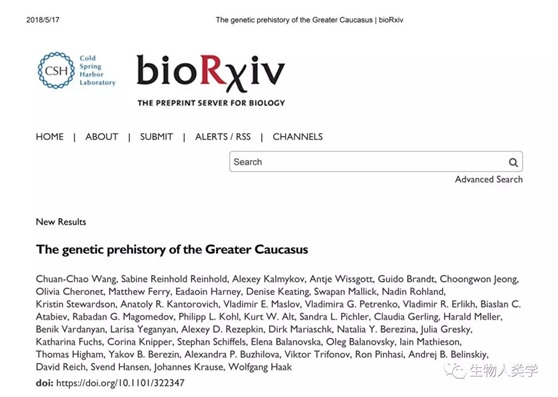Wang Chuanchao et. al.’s article appear as preprint on BioRxiv

On May 16, an article entitled “The genetic prehistory of the Greater Caucasus” co-authored by an international research team was posted as a preprint on BioRxiv. The 46 researchers on this team hail from 36 research units across the world including Department of Anthropology, Xiamen University; German Maple Institute, German Archeological Institute; Russian Federation of Cultural Heritage; Department of Anthropology, University of Vienna, Austria; College of Archeology, University College Dublin, Ireland; Lomonosov Department of Archaeology and Anthropology Museum; Moscow State University, Russian National Museum of Oriental Art; Department of History, Dagestan Institute of Archaeology and Ethnography, Russian Federation; Department of Anthropology, Wellesley College, USA; Prehistoric and Archaeological Sciences Institute, University of Basel, Switzerland; German National Heritage Museum etc. Wang Chuanchao, a researcher from the Department of Anthropology and Ethnology of Xiamen University, is the first and corresponding author of the article and the only co-author from China on this international team.

In recent years, Archaeogenetic studies have found that the steppe people of the Yamnaya culture of the early and middle Bronze Ages were the likely result of a mixture of Eastern and Caucasus hunter-gatherers. However, it remains unclear when and where this ancestral group arose and whether it was related to a series of cultural and technological innovations and dispersal of Indo-European Languages in the 4th millennium BCE. To find the answer, Wang Chuanchao et.al. generated genome-wide SNP data from 45 prehistoric individuals along a 3000-year temporal transect in the North Caucasus. By comparing with the ancient and modern populations through the published data, they found that the prehistoric people of the North Caucasus were genetically different from those of the adjacent steppe, but were genetically similar to the contemporaneous populations of the South Caucasus. The steppe groups from Yamnaya and subsequent pastoralist cultures show evidence for previously undetected Anatolian farmer-related ancestry from different contact zones. The ancestral components of the agricultural population were most likely to have entered the Eurasian steppe via the route on the western side. The findings of the study are deemed critical for the comprehensive analysis of the early origins and spread of the Indo-European populations. Meanwhile, the Steppe Maykop individuals are found to harbor additional Upper Palaeolithic Siberian and Native American related ancestry, indicating their wide distribution in the Eurasian steppe once upon a time.
The study was funded by the German Max Planck Institute, the German Institute of Archeology, and the Nanqiang Top Youth Talent Support Program of Xiamen University.
Paper Link:https://www.biorxiv.org/content/early/2018/05/16/322347





